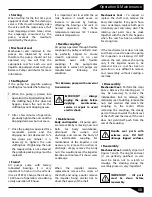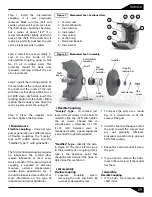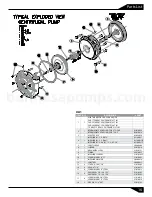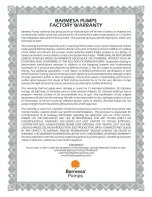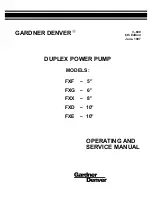
Risk of electric shock. Always disconnect the pump from the power source before handling inspections or repairs.
Troubleshooting Chart
PROBLEM
PROBABLE CAUSE
CHECK
- Threaded joints in the suction tightness.
- Gaskets for no wear.
- The mechanical seal for leaks.
- The drain plug has leaks.
- The vacuum gauge may be leaking.
2. Insufficient liquid in the
pump casing.
- T
hat the pump´s body is lled with wat
er.
3. Low operating speed.
- The motor speed (RPM).
- Impeller rotates freely.
- Internal parts are clean.
5. Mechanical defect.
- That the internal parts are not worn.
B) The pump does not prime,
the vacuum gauge reading
indicates higher than normal.
1. Pipe clogged suction.
- The suction line is clean.
1. The pump speed is very
low.
- The voltage is correct.
2. Mechanical defects.
- The internal parts for wear.
- The discharge is clear of obstructions.
- That the discharge valves operate correctly.
1. suction dynamic level
too high.
- When the pump is operating, never lacks
water in the suction.
- For leaks in suction piping, anges and Ā
gaskets.
- That there is no vortex effect at the end of
the suction, this lack of water.
- That screws are tight at the base.
- There are no cracks in the base.
- The dynamic level is not too high
- That the pumping capacity is not too much.
- The pump is operating in the range of NPSHR
- If r
educing o
w makes the noise gone, then
the problem is in the point above; partially
close the discharge valve.
- The bearings for wear.
- That there is oil in the deposit.
- The impeller does not have any foreign
material.
- The pump is operating in the range.
- That the alignment is correct.
1. Low Voltage.
- The voltage is correct.
- The amperage of the plate is not exceeded.
- There is no foreign material that may force
the impeller.
- That the motor is suitable for the pump.
2. Overload.
A) The pump does not prime,
the vacuum gauge indicates a
lower reading than normal.
F) The pump priming pumps
well and satisfactorily but noisy.
E) The pump loses its priming
during operation, vacuum
gauge reading drops to zero.
G) Motor overload.
4. Vibration.
1. Pump base is loose.
2. Cavitation.
3. Bearings.
2. The pump is sucking air.
D) The pump priming good
vacuum gauge reading is
almost normal, reading the
manometer is greater.
1. Discharge obstructed.
1. Air leak in the suction
system.
4. Bound pump.
C) The pump priming good
vacuum gauge reading is
normal, the manometer
indicates a lower pressure than
normal.
NOTE:
Barmesa Pumps assumes no responsibility for damage or injury due to disassembly in the field. Disassembly of the pumps or supplied accessories other
than at Barmesa Pumps or its authorized service centers, automatically voids warranty.
barmesapumps.com
21


